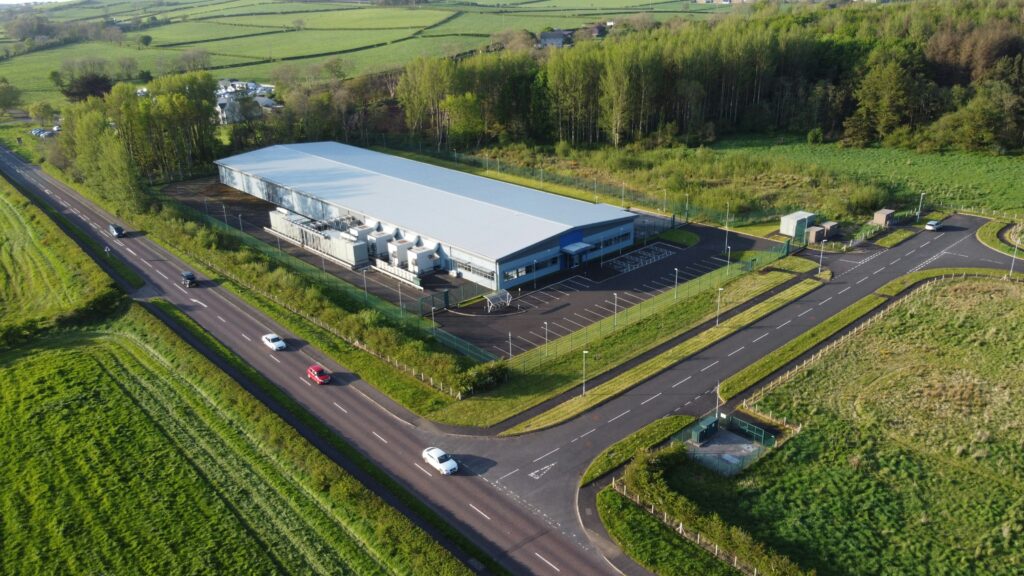The Data Centre Dilemma
Communities and tech firms are at loggerheads over the vast material resources feeding AI’s rapid rise.
Artificial Intelligence (AI) is being woven into our daily routines at pace. Often, the technology works behind the scenes in complex sectors like banking, healthcare, agriculture, and finance. Other times, it feels more palpable, arriving in the form of memes, adverts, social media trends, and the search engines we rely on, subtly shaping today’s economy and steering the one to come. According to market projections from PwC, AI will contribute up to $15.7 trillion to the global economy by 2030.
A prevailing message attached to AI is that it is an almost divine and inevitable technology that will help us overcome any challenge, especially the most pressing ones. The constant standardisation of AI indicates that it is not a passing trend but a technology on which most economic capabilities are betting.
But while we often marvel at AI’s capabilities, there’s a side of it we rarely see: the vast, material infrastructure sustaining it. AI still needs tangible machines – massive hyperscale data centres – to exist and thrive.
A not-so-artificial footprint
In 2023, the regional government of Castilla La-Mancha in Spain gave the green light for Mark Zuckerberg’s Meta to build an expansive new data centre near the town of Talavera de la Reina, located some 115 kilometres southwest of Madrid. The Meta Data Center Campus facilities are set to span 191 hectares of land and will need a total of 504 million litres of water per year, mostly coming from the Tagus River, according to planning reports from the local government. This would represent roughly 8% of the Talavera de la Reina’s total water consumption, said RTVE, Spain’s public broadcaster.
The refrigeration technology at the centre is set to draw some 40.6 million litres of water per year from public water supplies, of which an estimated 38.4 million litres will be returned to the public utility’s wastewater system, sources from the regional Castilla La-Mancha government told REVOLVE. “Meta has also expressed their commitment to restore more water than they consume at the Talavera Data Center by supporting local water restoration and conservation projects,” the source added.
The energy requirements of the planned data centre in Talavera de la Reina are harder to pin down. Regional government sources said the centre would run off “100% clean and renewable energy.” According to Spanish daily El País, the centre will have a planned installed capacity of 248 megawatts.
While regional government insists the data centre plans comply with environmental requirements, both in terms of water consumption and physical encroachment on natural ecosystems, the project has sparked a pushback from local activist groups.
The movement Tu nube seca mi río (“Your cloud dries out my river”) was created in direct response to the data centre project in Talavera de la Reina, although has since expanded to take aim at other data centres in Spain. Along with a network of other environmentalist groups, including SEO Birdlife, it has accused tech companies and regional authorities of ploughing ahead with data centre plans despite water shortages and environmental damage, and with “unfounded” promises of new jobs in rural areas.

When the Talavera de la Reina project was approved in 2023, it was hailed as the largest such development project in the region, with local authorities touting an estimated 250 direct jobs once it is up and running (with a further 300 jobs in the construction phase). “Its commitment to the community will have a positive impact at a local level, hiring locally both the materials for the construction phase and the people who will be part of the team,” the government source told REVOLVE.
These employment promises, however, raise little more than eyebrows among activist groups, who point out that many data centre jobs can be done remotely. Tu nube seca mi río says that rural areas are less equipped to protest against the arrival of big data centres. “We realised that in Spain the problem is even more difficult because rural areas are so depopulated,” Aurora Gómez, a member of the group, told REVOLVE. “The population is very old, and most young people – especially those who want change – have moved to cities. There are very few left to resist.” The Meta Data Center Campus is one of the latest in a series of such facilities to take root in Spain amid a digitalisation boom. Tech behemoths Amazon and Microsoft, among many others, are also setting up shop in the Iberian nation. Amazon Web Services, a cloud computing services subsidiary of Jeff Bezos’ company, has three data centres in the Spanish autonomous region of Aragón. In 2024, the company announced plans to expand these centres with a reported investment of 15.7 billion euros (roughly $17.7 billion) until 2033.
Water tensions
The sector is booming. According to Research and Market, the global “Data Centre Market is expected to reach $613.36 billion in 2033 from $237.07 billion in 2024.” Estimates from ABI Research, a tech intelligence firm, suggest there will be over 8,300 public data centres worldwide by the end of the decade. And according to International Energy Agency Executive Director Fatih Birol, “global electricity demand from data centres is set to more than double over the next five years, consuming as much electricity by 2030 as the whole of Japan does today.”
Energy is just one part of the equation. Water consumption is soaring. A hyperscale data centre can consume up to 760 million litres of water per year (2.1 million per day) according to figures from DGTL Infra. To put this into perspective, Spain’s National Statistics Institute reports that the average person uses about 130 litres of water daily.
In Spain, the concern about water use is particularly acute. Around 75% of the country’s territory is at risk of desertification, according to the government. In the summer months, it is common for local authorities to warn citizens to limit water consumption due to drought. The allocation of this increasingly precious resource to big tech firms, then, can leave a bitter taste in the mouth of the public.
Companies like Amazon have pledged to become “water positive” by 2030, returning more water to communities than is extracted in data centres. It must be noted that this aim does not mention the indirect water consumption from the power plants that fuel the data centres. In Spain, Amazon’s bid to expand its existing data centres in Aragón was criticised by a collective of environmentalist groups, including Tu nube seca mi río.
The group detailed a long list of complaints, alleging that the energy consumption of these data centres would surpass that of the entire region of Aragón and that the water needs would not be compatible with availability. Amazon already informed the regional Aragonese Institute of Environmental Management that it would need to raise its water use for its three Aragón data centres by 48%, up to nearly 53.9 million litres per facility each year.
Growing awareness, pushing for transparency
The environmental impacts of data centres on their immediate surroundings are just a small part of a larger problem. Vital information about AI’s material footprint is still largely hidden.
Sara Marcucci, a researcher focused on technology, policy, and social justice, and co-founder of the AI + Planetary Justice Alliance, told REVOLVE that the framework they have developed to assess the impacts of AI systems across their entire lifecycle seeks to ask the right questions despite knowing that “99% of them are unanswerable.”
“The supply chain is completely opaque, we don’t have the expertise or the data. These questions are rarely asked, and are often raised in disciplinary or geographic silos. A lot of meaningful work is happening, but it’s fragmented, and our hope with the framework is to help make that conversation more visible and connected,” Marcucci said.
Mapping, identifying what is known and what is not, is a necessary step to fostering debate and accountability. This means examining every stage of the production process from the extraction of raw materials to the manufacturing of chips and equipment, their disposal, and the impacts associated with the deployment and operation of data centres. This opacity contradicts the green branding often pushed by big tech firms. Greenpeace International raised early warnings about this issue in reports from 2011 and 2012, which already flagged the sector’s alleged lack of transparency regarding energy use and environmental impacts. Despite over a decade of pressure, progress remains slow. The Uptime Institute’s 2024 global report revealed that while 82% of data centres track electricity use and 70% monitor Power Usage Effectiveness (PUE), only half monitor water usage, and a mere one-third track carbon emissions or e-waste disposal.
While 82% of data centres track electricity use and 70% monitor Power Usage Effectiveness (PUE), only half monitor water usage, and a mere one-third track carbon emissions or e-waste disposal.
– Uptime Institute
Environmental, social, and political implications
The issues around AI are not just related to the technology but the open questions about everything that supports it. As Marcucci put it: “AI is not just a technological issue, it’s a geopolitical one. It’s about land, people, and power.” From extracting minerals like lithium and cobalt to manufacturing servers and their eventual disposal, every stage of the AI lifecycle has environmental, social, and political consequences.
This has triggered protests around the world. In Chile, activists from Cerrillos (Santiago) opposed Google’s planned water-intensive data centre near the drought-stricken capital of Santiago. In Dublin, community groups raised concerns over data centres straining the country’s electricity grid. In the Netherlands, public outrage over plans for massive Microsoft and Meta facilities led to stricter regulations.
Still, questioning AI’s sustainability is not about rejecting technology altogether, it’s about scrutinising the necessity and context of its deployment.“I don’t think that if you use ChatGPT then you are a bad person,” Marcucci said. “Also, I don’t think individuals are going to change the world, but individual agency and awareness is what brings about collective action.”
It is a matter of context, not a blanket rejection. Marcucci added: “Of course, these models are useful, but are they that useful? Do we really need a new model every time? The huge central point to start from is: why are we doing this?”
Toward sustainable AI?
Amid a climate crisis, the word ‘sustainability’ crops up frequently, often with different meanings depending on who is using it. Technology companies are committed to buzzwords like ‘carbon neutrality’ and ‘water positivity.’ But the DNA of a hyperscale data centre, however well-intentioned, is to grow as much as the company needs. This, in essence, contradicts the future safeguarding of natural resources.
“When you damage a site, that damage is likely to be irreversible,” Dr. Sebastián Lehuedé, a researcher focused on the governance of digital technologies from a social justice perspective, said in an interview with REVOLVE. “Having a nice project on Amazon does not mean that the damage being done by the data centre can be negated, it still counts as irreversible.”
While the European Union has introduced certain environmental regulations that affect data centres, such as the EU Energy Efficiency Directive, Brussels’ approach needs to improve, according to Paz Peña, a researcher focused on digital technologies, feminism, and social justice.
As of 2025, directives require data centre operators to disclose energy consumption, water use, and reliance on renewable energy. This effort to improve transparency is a step in the right direction, offering valuable data that could inform more sustainable practices across the sector.

However, the EU’s directive still lacks strength. Reporting requirements alone do not guarantee meaningful change. Without binding targets for efficiency or renewable energy use, companies are not compelled to reduce their environmental impact significantly. As AI technologies accelerate and demand for data processing grows, this regulatory gap risks allowing unchecked environmental degradation. Legislative proposals may be on the horizon, but until concrete, enforceable standards are in place, voluntary compliance is unlikely to be enough.
Beyond techno-solutionism
In mainstream narratives, AI is often framed as a miraculous fix for the world’s most pressing issues, from hunger to climate change. This techno-solutionist mindset suggests that complex political, social, and ecological challenges can be overcome with better algorithms and more computing power. However, relying on technological fixes without addressing deeper systemic problems risks reinforcing existing inequalities rather than dismantling them.
Relying on technological fixes without addressing deeper systemic problems risks reinforcing existing inequalities rather than dismantling them.
– Sara Marcucci, co-founder AI + Planetary Justice Alliance
Without questioning who designs AI, who owns it, and who profits from it, we risk embedding new layers of injustice within digital infrastructures. As Peña suggests, instead of pursuing broad, universal solutions that often serve dominant interests, we need localised, community-driven approaches that prioritise socio-ecological sustainability.
Researcher Lehuedé also warned against narrowing our imagination through the unchecked spread of AI, particularly in fields tied to land, culture, and the environment: “When one sees this application of AI, my question is always this: in what way does more artificial intelligence imply fewer worldviews or fewer ways to connect us with the world? Because that is the diversity we need to overcome climate change.”
The debate about AI and data centres should not be limited to its potential to optimise industries or automate tasks; it must also confront the political, social, and environmental realities embedded in every line of code and every server farm built.
The resistance emerging in Spain, Chile, and the Netherlands is not merely a localised pushback against technological encroachment; it embodies a deeper, more profound call to question the foundations upon which our digital future is being constructed.
There may be no easy answers. Yet ignoring these questions ensures that AI will continue to deepen the divides it claims to bridge.
AI is growing exponentially, so there must be a global movement for transparency, justice, and ecological balance. The challenge is not simply to regulate the technology, but to reimagine its foundations – placing ecological limits, community well-being, and human dignity at the core of innovation. In the race to dominate AI, we cannot afford to lose sight of the bigger race: the one towards a liveable, just, and sustainable planet.
